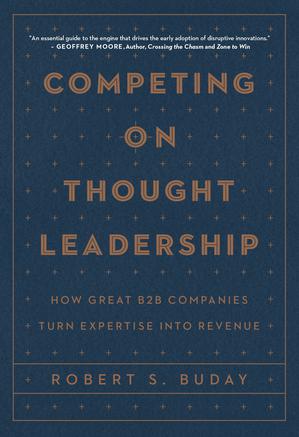
COMPETING ON THOUGHT LEADERSHIP | Kirkus Reviews
[ad_1]
A business book offers a comprehensive, itemized look at the nature and practice of effective leadership.
Buday makes clear at the outset of his work that he’s well aware of the devaluation the term thought leadershiphas undergone in the last two decades. What he refers to as “the supply side of thought leadership”—“inventing revolutionary concepts that improve how businesses operate, marketing those concepts well, and attracting adulation and new business”—has been “slapped on blog posts, white papers, research reports, sections of websites and many other things that turn out to be (upon inspection) not highly thoughtful.” The author aims his own breakdown of these concepts at the business-to-business market and the executives and consultants in this sector, seeking to explain the nuts and bolts of such buzzwords as “customer loyalty management, disruptive innovation, blue ocean strategy, lean startup, and emotion intelligence, to name just a few.” He hopes to differentiate the key concepts from the “useless debris calling itself thought leadership” that’s now floating around in “the vast cosmos of business ideas.” He goes about this in ways that will be familiar to readers of business literature: categories and sub-categories, from “the 4 pillars of thought leadership” to “the nine hallmarks of compelling content.” He expands on a wide variety of business-related topics, from the perils of stressing marketing over content (“a marketing-centric view of thought leadership is guaranteed to confine a company to thought followership status, not thought leadership”) to the burgeoning prevalence of the whole thought leadership fad, fueled by things like TED Talks and national conferences.
Buday’s rhetoric about all of this is forceful and very readable. While trying to explain the explosion of thought leadership, he blames the escalating complexity of the business world. “Executives need to figure out their companies’ strategic direction,” he writes, “how to create demand and supply for their products and services, how to stage productive innovation, and how to attract and keep talented people.” Although it’s perhaps surprising how many of the author’s points revolve around not boardroom tactics but the generation of prose (“Writing, and writing, and writing some more,” as he puts it), what’s sometimes less than clear about his book is what, if anything, separates it from the ocean of “useless debris” he mentions at the beginning of his work. His volume, granted, is aimed at the kind of C-suite readers who a) think there even is such a thing as thought leadership (as opposed to simple, good business practices, which have been recognized in every consumer culture since ancient Sumer) and b) believe it’s intensely important to the running of their companies. Such readers will doubtless appreciate the difference between “business reengineering” and “massive layoffs,” for instance, and for that audience, Buday’s book should provide a bracingly no-nonsense series of clarifications about where B2B priorities should fall. If the author is right and the corporate world is more intricate than ever, this work should deliver some clear navigation.
A powerfully written dissection of thought leadership for the business world.
Pub Date: today
ISBN: 978-1-64687-100-1
Page Count: 258
Publisher: Ideapress Publishing
Review Posted Online: Dec. 14, 2021
[ad_2]
Source link

Comments (0)